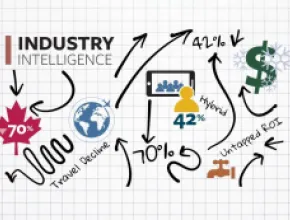The business travel industry is on its way to full recovery, and while we are not quite at pre-recession levels yet, there are some strong signals that reaching that point is not far off.
Falling in line with this trend is an increase in meetings. In 2010, companies in the Americas spent more on client-facing meetings and events as they were looking to create connections, primarily to support business growth.
Along with this return, based on data from the 2011 American Express Global Business Travel Forecast, we expect to see continued rate increases for corporate meetings and events as demand strengthens. In order to maximize meeting spend, companies are implementing strategic meetings management programs and generally showing greater appreciation for the complexity and risk of managing this key budget category.
One factor compounding meeting costs is the trend of companies booking meetings closer to the date they are to occur. We are seeing a reported 20 percent to 30 percent reduction in lead time, along with corporate budgets being released later and properties in key markets already at capacity for 2011, all are impacting available discount rates and space availability for companies.
There are several other drivers impacting the meetings landscape for 2011. Suppliers are regaining their pricing power as demand returns, meetings are smaller as organizations define the need and scope of meetings internally, and technology is changing not only meetings but the entire process surrounding them, from coordination to transportation. Here are some thoughts on navigating this landscape in the coming year.
Suppliers in Better Position
Suppliers are gaining strong pricing control as meeting planners increase their meetings volume. Many companies’ meeting budgets have increased but are very closely monitored, and in response to this, along with recognizing this pricing power shift to the supplier in 2011, meeting planners will be heavily focused on making meetings achieve maximum return on investment, both monetarily and in the form of return on attendee experience/stakeholder objective.
A recent Maxvantage Travel Buyers Survey tells us that the meetings industry has gradually improved. With demand and need for meetings continuing to increase, availability has become more scarce and meeting planners have increasingly found it more difficult to secure available space and more challenging to negotiate favorable rates.
One concrete link: Data from American Express Business Travel’s Q3 Business Travel Monitor (BTM) confirms a recovery, showing domestic hotel rates have increased by 3 percent year-over-year. Additionally, the 2011 American Express Global Business Travel Forecast projects North American corporate negotiated hotel rates could climb as much as 6 percent for upper-range hotels. It is recommended that buyers start to look further ahead on their calendars to secure space for meetings in 2012 and 2013, especially large events, to ensure availability.
As demand for travel continues to rise, getting to and from meetings will also get more expensive. For the third quarter of 2010, BTM data already shows airfare both domestic and international increased year-over-year by 6 percent and 8 percent, respectively. The 2011 American Express Global Business Travel Forecast projects North American airfares domestic and international could climb up to 6 percent and 7 percent, respectively.
As rates climb and suppliers’ negotiation position strengthens, companies must have a keen sense of the competitiveness of their supplier contracts, corporate policies, demand management and compliance techniques. By effectively managing these levers, organizations will minimize the impact of price increases and avoid costly penalties
The New Meeting in 2011
What will meetings look like in 2011 as organizations adjust to developing industry trends such as higher rates? In short, we expect meetings will be smaller in scale and less extravagant in 2011 than they were pre-recession. Also, meeting planners will look to hold more meetings in less expensive locations and areas where they have been able to secure the best rate in negotiations and continue to keep costs down.
Despite the reduction in lead time for meetings in 2011, companies are doing more cost analysis and better sourcing to find the most cost-effective locations and venues available to still make every gathering possible and effective. Meeting planners must make the most of rate benchmarking data to optimize on markets that haven’t seen the same spikes in hotel rates as other higher demand top-tier markets.
Technology Plays Key Role in 2011
Virtual meetings are increasingly being incorporated in corporate travel and meeting programs. Our data shows executives are looking to invest in this technology as a means to create an infrastructure that supports business as usual needs while keeping an eye on the bottom line. We expect in 2011 to see this solution being utilized more where and when appropriate.
With these advancements in technology, however, meeting planners and travel managers must be able to determine the best course of action between a virtual meeting and the traditional in-person meeting. One of the driving factors behind making virtual meetings a more appropriate solution is the expansion of telepresence facilities. At American Express Business Travel we have partnered with Cisco, Tata and Regus to help planners and travel managers not only gauge which type of meeting makes the most sense for their company but also provide an inventory of telepresence facilities in regions around the globe.
Effectively using meeting technology is critical to ensuring travel programs are continually successful and that every dollar goes where it should, whether it is on travel arrangements for a face-to-face gathering or investing in capabilities that allow for certain meetings to be held virtually. Instituting policies to govern and manage this expense category is of growing importance as well, as virtual meetings are often falling outside of the view of the meeting program manager.
Finally, we’ve seen mobile technology become a valuable utility in assisting travelers before, during and after meetings and events. As the proliferation of smartphones continues in 2011, companies can find new ways to benefit from mobility, particularly for meetings, by using mobile devices as a way to gauge interest in certain elements of a meeting, and from there, to develop ways to make meetings and events more efficient and effective, even in real-time.
Reinvesting in meetings
To summarize, companies are reinvesting in meetings. Having withstood the test of the recession, the importance of meetings and events and their ability to drive growth is clear. Meetings are making a comeback, and while this demand comes along with higher rates, companies will need to manage this category strategically by leveraging their assets to be successful in holding effective gatherings and making meaningful connections in 2011 and beyond. MFTIssa Jouaneh is vice president of Maxvantage and American Express Meetings & Events.
Need to Know
- 20% to 30% reduction in lead time
- Corporate budgets released later
- Domestic hotel rates increased 3% year-to-year
- Hotel rates could climb as much as 6% for upper-range properties
- Airfares increased 6% (domestic) and 8% (international) in third quarter, year-over-year Airfares could increase up to 6% (domestic) and 7% (international) next year






